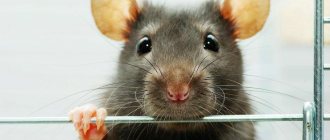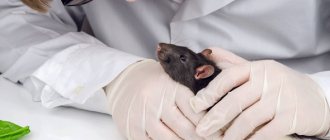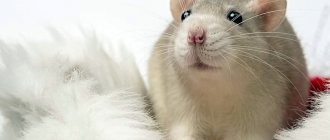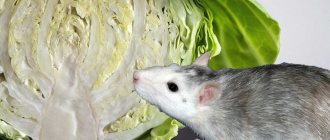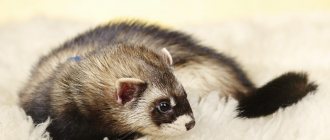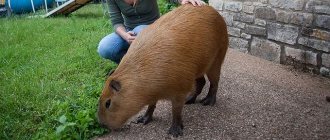Oddly enough, among all types of decorative rodents, domestic rats are becoming increasingly popular. These animals are very friendly, easy to care for, do not require much space to keep, and can always cheer you up. Moreover, it is believed that rats are very intelligent creatures, smart, cunning, and have a good memory.
There are a huge variety of rat breeds, which differ in size and type of fur. The main ones are presented in the photo below.
Classification of rats depending on body type
Based on body type, domestic rats are divided into main groups:
- Standard. Pets have a proportional build. They are slender and quite flexible. The size of the tail of decorative rats is almost equal in size to the length of the entire body with head. The shape of the tail tapers from the base to the tip. The eyes of this breed of pet are round and large. The ears are located on top of the head and are proportional in size. The fur of such animals shines slightly and is located throughout the body. Standard rats are the largest ornamental rodents. Their weight ranges from 300-500 grams, directly depending on the animal’s nutrition, as well as its gender. Females are more mobile. Their size from nose to tail reaches about 25 centimeters. Males may be larger.
- "Dumbo" rats. They originated in California. They were brought out in 1991. A distinctive feature of these animals is the structure and location of the ears. In the Dumbo breed they are located lower, not at the very top of the head. The shape is also different. The ears look rounder and wider. In these rats, they can be completely open, and also have a slightly bent upper edge. Some pets have a slightly protruding nape. The body shape of this type of animal widens slightly at the back, resembling a pear. However, the body parameters are smaller than other breeds.
- Tailless rats. The name of these rodents speaks for itself. These animals are characterized by the absence of a tail. Moreover, these animals can be either with or without fur, wavy and curly. The color of the coat is also completely varied. The shape of the body is mainly pear-shaped.
Location
Where the black rat lives is a very interesting question. The favorite habitat for the rodent is sea vessels. Rats live side by side with humans and eat identical food. They spread around the globe thanks to water transport.
The black rat is less inventive than its relative the Pasyuk. Content with little. Settles near reservoirs and rivers. But it is less attached to water than the gray one. Does not build nests in the ground, avoids water, but if necessary, swims quite a long distance. It does not dive because fish, fry, and amphibians are of little interest to it.
Willingly settles in the forest, fields, and edges. The lifestyle is more reminiscent of voles. In urban areas, it prefers sewers, abandoned buildings, garages, garbage cans, and entrances. Can live in a person’s house, occupying the upper floors or attic.
Classification of rats by hair type
Depending on the type of fur, decorative rats are also conventionally divided into several groups. In standard animals it shines and lies evenly throughout the body. The tail, fingers and paws of the animal are covered with a short thin fur coat. The ears seem to be shrouded in down, making them very soft and silky. Long vibrissae are located on the cheeks of the animal, and short and thin ones are located above the eyes.
Curly rats. The whiskers of this type of animal are much shorter and curled downwards. On the top of the back, these animals have very curly velvety fur, but less shiny than the standard type. The tummy of different species can be either curly or absolutely smooth.
Wavy rats. They differ from the standard breed by the presence of wavy, thick wool, which is very soft and fluffy to the touch. Because of the peculiar waves, sometimes a rat can seem quite unkempt and unkempt.
Downy rats. Characterized by the presence of thin soft fluff instead of wool. The hairs are located throughout the body rather sparsely, and they are also short in length. The mustache is characterized by a curled shape and is short.
Sphinx. The uniqueness of this breed is the absence of wool. These rats are completely hairless. The skin of such animals must have a beautiful, healthy appearance with a bright color. Rodents of this type can be covered with small, thin fluff only in certain parts of the body, for example, above the eyes or on the cheeks.
Rex. Such animals look very cute because their fur is not evenly laid, but sticks out a little in different directions. There are only a few such rats, but they look very original and impressive. The whiskers of this species of animal have a twisted shape and a rather short length.
Double Rex. This species can be either bald or with fur. Moreover, throughout the life of the animal, in those areas where there was never fur before, it can grow, and vice versa, in fluffy places the villi disappear. The whiskers of this type of rat are generally curled and short in length. Sometimes there are decorative rats of this breed with a double coat. The fluff is often slightly curled and tousled.
Long-haired rats. The fluffiest of all the above animal species, their hairs are of considerable length.
Satin. These rats have beautiful, thin and long fur. This breed is very beautiful, has shiny fluff with a bluish tint. This feature attracts all lovers of domestic rats.
Husky. This is a decorative species with a varied coat color. Most often you can find white-gray individuals. At birth, these animals mostly have snow-white fur, but over time the color changes. Another feature of this breed is eye color. While standard rats have black eyes, Huskies can have eyes of all shades of red.
Which breed is better to choose?
Given such a variety of rat breeds, novice breeders often wonder what type of pet to buy. To make the right choice, you must be guided by the following criteria:
- Price . Among decorative rats there are both expensive and affordable breeds. If the financial situation does not allow you to pay a large sum for a rat, it is better to choose the classic option - the standard.
- Animal size . Breeders who prefer compact rodents should pay attention to varieties such as Dumbo or Manx. If large pets are in favor, the ideal option would be a standard or satin breed.
- Presence of allergic reactions to wool . An ideal option for allergy sufferers would be the Sphinx or Fuzz. Although the latter have fur, it is very short and practically does not grow. But it is better for breeders prone to allergies to avoid Double Rex and Pseudo-Sphinx rats - rodents of these breeds shed heavily.
- Appearance . Quite often, when choosing a decorative rat, buyers focus solely on appearance. The main thing here is to choose the animal that you like most.
- Lifespan . In general, rats do not live long - about 3 years. However, representatives of some breeds do not live to this age due to health problems, for example, rexes or sphinxes. Among the long-livers are Dumbo, Husky, and Fuzz.
- Unpretentiousness to living conditions . If you plan to purchase a rat that is not very sensitive to external conditions, it is better to purchase a standard or albino breed. Among the demanding rodents are sphinxes, fuzzes, and rexes.
The types and breeds of rats are amazing in their diversity. And each variety has its own characteristics, advantages and disadvantages. Therefore, before buying a pet you need to weigh the pros and cons. After all, a rat is not only a pet, but also a faithful friend for all family members.
Classification of decorative rats depending on color
In this article, we have already looked at what types of domestic rats there are, depending on their body shape and the type of their fur. But what colors can the hair of your pets have?
In the modern world, many scientists are constantly trying to breed completely new species of domestic rats. This is mainly related to medicine. As you know, these cute creatures are often used in science. Doctors all over the world conduct various experiments on them, thus creating medicines to treat various diseases. Thanks to these animals, scientists have tested a huge variety of medicines that undoubtedly help people survive.
For many years now, different types of ornamental rats have been crossed, resulting in hybrid species.
As for the colors of animal fur, they are predominantly white, black, gray, brown, orange, blue, beige, and black and white. The color of the eyes also depends on the color of the hair. Often, rats with white fur have black or red eyes. Species with a blue body tint most often have ruby-colored eyes.
There is also a separate species of rats whose fur has three colors. Such rocks are called mosaic. They are found very rarely in the modern world, therefore they are considered one of the most valuable. Moreover, the colors of this mosaic can be absolutely diverse. Most often, the color contains a white tone or various light shades. An interesting fact is that this breed of rat does not pass on its color by inheritance; a tri-colored female can give birth to pups of the same color.
As you can see, there is a huge variety of breeds of decorative pet rats. If you decide to get yourself such an animal, you definitely won’t regret your choice. Once your pet gets used to you, it will become completely tame and dependent on its owners. These creatures are very friendly and do not bite even when handled roughly.
Habitat
Black rat: resident of the city and field.
Rats of this species are found in Europe, Asia, Africa, America and Australia. In Asia, where a temperate climate prevails, black rats are rare, since this area is the natural habitat of the gray rat.
But the climate of Australia turned out to be especially favorable for the black rat, while the pasyuk did not take root in this area.
On the territory of Russia, the black rat is found in the European part of the country from Arkhangelsk to the Caucasus. The rodent lives:
- in the Far East;
- Sakhalin;
- Kamchatka;
- Shikotana;
- Commander Islands;
- in Ussuriysk;
- Komsomolsk-on-Amur;
- Khabarovsk;
- Blagoveshchensk.
You can meet the gray rat Pasyuk, with whom the main character is so often compared, here.
Features of caring for decorative rats
Rats do not require too much space; they only need a small cage with ladders of various shapes, a house, a hammock, a wheel, where they can run or play with any other accessories.
They are also particularly unpretentious in nutrition and are considered omnivores. However, as for the correct diet, it definitely must be present, since the rodent needs all the useful substances and microelements for good health and excellent mood. It is enough to feed rats twice a day, morning and evening. At night the portion should be larger.
This is due to the fact that these creatures are nocturnal inhabitants. The diet must contain grains, cereals, vegetables, fruits, and dairy products. Don't forget to regularly change the water in the drinking bowl so that your pet doesn't suffer from thirst.
The main disadvantage of these cute creatures is their short lifespan. In general, rats do not live longer than three years, and this applies to absolutely all breeds. Therefore, an important piece of advice when you buy a pet is to choose a rat that is no more than one and a half months old.
With proper care, any breed of domestic decorative rat you like will always delight you and your child with excellent health and good mood.
Nutrition
The black rat can hardly be called a predator. The rodent prefers plant foods, plant seeds, grains, vegetables, and fruits. Protein foods make up a small part of the diet. Occasionally eats beetles, worms, and may covet bird eggs.
Interesting!
A rodent eats 15 g of food and 15 ml of water per day. Hunger is difficult to bear. In the absence of food, it can live no more than 2 weeks. If there is a shortage of water, it dies within a week.
Baby rats
Interesting Facts
Rats, leading a nocturnal and hidden lifestyle, are very interesting animals that can surprise you with their abilities. Here are some interesting facts about these rodents.
- Rats cannot distinguish between colors and shades. Everything around them appears to them as spots of various sizes and brightness that are in motion. Visual acuity is very low, but it is compensated by very fine hearing. Such hearing allows them to determine the direction and distance of even the slightest noise and rustle, as well as understand their cause. They also have a highly developed sense of smell.
- Another amazing ability of rats is that they have inner vision, which is capable of anticipating disasters and disasters. This is confirmed by the well-known fact that rats always flee a sinking ship in advance. During the Battle of Stalingrad, rats left the city en masse before a German air raid.
- An amazing event that occurred in France at the beginning of the twentieth century confirms the ability of rats to foresee events. From one food market that was closing, all the rats living there, one day before the closing, unanimously moved to the exact place where it was moving. How the rats found out about this remains a mystery, since the market's move was only announced in the newspaper.
- There are mutant rats. In New Guinea, in the area of the Bosavi crater, American scientists discovered rats reaching 80 cm in length and weighing about 1.5 kg. But in character, despite their terrifying size, they are completely harmless, non-aggressive and sociable.
- In terms of mental development, the rat is superior to cats. Rats can communicate with each other by emitting high-frequency sounds that mean certain concepts and words, and they sound the same in different rodents. Scientists state that rat sounds are similar to human communication.
- Rats are amazingly clean and hygienic. They can bathe for several hours a day. Rodents have absolutely no fear of water and dive well.
- They also have a good memory and can remember the route the first time. Therefore, they are not able to get lost and determine the correct path in the labyrinths.
- The rat has a strong immune system and is not susceptible to almost any disease. This is a consequence not only of their cleanliness, but also of their innate good health. Scientists have discovered a gene in them that protects individuals from sexually transmitted infections.
- Research by scientists has shown the similarity between humans and rats: the structure of the human and rat brains is very similar, and the blood components are 80% the same.
- The physiological feature of the rat's heart is that it makes from 300 to 500 beats per minute.
- Rats appeared on our planet 48 million years earlier than humans.
- A rat can swim many kilometers for three days without stopping, and can drown only if it cannot get out of the water.
- The gray rat can run at a speed of about 10 km/h, jump up to 80 cm in height, and in a state of aggression - up to 2 meters.
- A rat can determine that food is poisoned even if the proportion of poison is minimal.
- The rat is the only mammal that can laugh.
The character of tame rats is fundamentally different from the character of their wild relatives. They can be fearlessly kept at home, tamed and receive love, trust and affection in return.
You will learn more about caring for pet rats in the following video.
Harm to humans
Black and gray rats are equally dangerous to humans. Rodents spread terrible diseases, carry pathogens, worm eggs, and fleas. In the previous century, the black rat was the main carrier of plague.
They spoil and destroy food supplies. They get into warehouses, barns, storage rooms, cellars. In the spring, an invasion of black rats is dangerous due to gnawing on the bark of young trees and the death of plants. In the fall, the harvest is spoiled.
In the house, pests gnaw on walls, furniture, decorative items, and wall insulation. Rodents even grind what is of no nutritional value to them in order to stop the growth of teeth.
Reproduction
Black rats are not as fertile as their pasyuki relatives. During the year, the female gives no more than 5 offspring under constant living conditions. In the wild, only 3 offspring are produced. With the onset of the cold season, sexual activity decreases.
There are from 3 to 11 cubs in one litter. In contrast to gray pasyuks, cannibalism is less developed. Females rarely eat the young, but protect the nest from the male. The animal enters into sexual contact with several males at once. Pregnancy lasts about 28 days.
Relationships in a rat family
Black rats live in colonies of several hundred individuals each. The colony is headed by one male and several females. The youngsters learn from the experience of the “oldies.” Young females help adult mothers raise their cubs. In one nest, the offspring of several females are raised and fed.
Males often conflict for a variety of reasons, the main ones being females and food. The defeated individual avoids its winner.
Each rat family owns a territory of about 2.5 square meters.
Life of rodents
They do not dig holes in the ground, but build nests in trees. A rat's building is similar to a magpie's nest. There are often cases when animals move into a ready-made nest, having first eaten its inhabitants.
Excellent climbing abilities allow black rats to move freely on both horizontal and vertical surfaces. The animals are able to climb to the very top of the tree, but they climb so high only when absolutely necessary.
During the day, black rats sit at home, hiding from sunlight, and under the cover of night they go in search of food. Caution is the key to any activity for a rodent. This is due to the large number of predatory enemies - animals with dark fur coats are eaten:
- birds;
- cats;
- dogs;
- hedgehogs;
- foxes;
- wolves.
The average lifespan of a wild rodent is 1-1.5 years. A decorative black rat kept as a pet can live for 4 years.
Baby rats
Newborn black rat cubs are characterized by the following:
- complete absence of fur;
- blindness;
- deafness;
- underdevelopment of the limbs.
With all this, kids have an excellent appetite. Every day, the pups noticeably change physically:
- after a week of birth, they start to have fluff;
- after 2 weeks they begin to see and hear;
- after 3 weeks, their skeleton and limbs are fully formed, after which the babies crawl out of the nest.
Month-old baby rats are already absolutely independent - they eat “adult” food, etc. Parents kick their offspring out of their nest, and the grown-up individuals begin an independent life, becoming full-fledged members of the rat colony to which their parents belong. In young females, puberty is completed by six months, after which they are ready to have their own offspring.
Preventive measures against voles
In addition to using various baits, be sure to keep the area clean; In late autumn, in order to protect against frost and pests, tie tree trunks with covering materials. After every big snowfall on thaw days, the snow around the trees needs to be trampled down: compressed, after a cold snap, it becomes an insurmountable obstacle for rodents.
When removing dead animals from the territory, you should remember that they are carriers of tularemia, a dangerous infectious disease. Therefore, under no circumstances should you pick up a vole with your hands.
Subsequently, in order to prevent water voles from entering the landscaped area, it is recommended to build a fence on a solid, deep (minimum 40 cm) foundation
It is important to ensure that there are no gaps in the fence sections or attachment points through which water voles could get inside.
